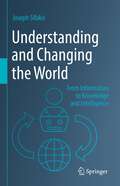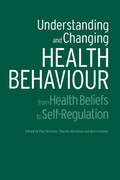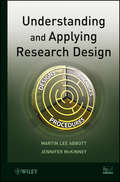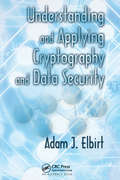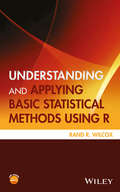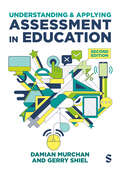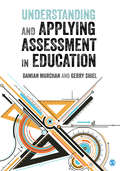- Table View
- List View
Understanding and Conducting Information Systems Auditing (Wiley Corporate F&A)
by Veena Hingarh Arif AhmedA comprehensive guide to understanding and auditing modern information systems The increased dependence on information system resources for performing key activities within organizations has made system audits essential for ensuring the confidentiality, integrity, and availability of information system resources. One of the biggest challenges faced by auditors is the lack of a standardized approach and relevant checklist. Understanding and Conducting Information Systems Auditing brings together resources with audit tools and techniques to solve this problem. Featuring examples that are globally applicable and covering all major standards, the book takes a non-technical approach to the subject and presents information systems as a management tool with practical applications. It explains in detail how to conduct information systems audits and provides all the tools and checklists needed to do so. In addition, it also introduces the concept of information security grading, to help readers to implement practical changes and solutions in their organizations. Includes everything needed to perform information systems audits Organized into two sections—the first designed to help readers develop the understanding necessary for conducting information systems audits and the second providing checklists for audits Features examples designed to appeal to a global audience Taking a non-technical approach that makes it accessible to readers of all backgrounds, Understanding and Conducting Information Systems Auditing is an essential resource for anyone auditing information systems.
Understanding and Changing Your Management Style: Assessments and Tools for Self-Development (J-B Warren Bennis Series #176)
by Robert C. BenfariAn update of the classic book that reveals the 6 keys to successful management In this new edition of his best-selling book, Robert Benfari explains that the best mangers are not born that way but share a mix of characteristics that can be analyzed, understood, and most importantly changed. He identifies the six characteristics of successful managers (Psychological Type; Needs/Motivation; Use of Power; Conflict Style; Our Basic Values; and Our Reaction to Stress) and uses these building blocks to show how anyone can use personality-specific strategies for resolving conflicts, solving problems, managing stress, handling difficult situations at work, and positively influencing others. Includes a proven pathway for becoming an effective manager Contains new information on management style and leadership, human nature and neuroscience, and the dark side of management Includes a self-assessment for each of the six building blocks to successful management This research-based book offers the tools leaders need to improve their management style and succeed in the workplace.
Understanding and Changing Your Management Style: Assessments and Tools for Self-Development (J-B Warren Bennis Series #175)
by Robert C. BenfariAn update of the classic book that reveals the 6 keys to successful management In this new edition of his best-selling book, Robert Benfari explains that the best mangers are not born that way but share a mix of characteristics that can be analyzed, understood, and most importantly changed. He identifies the six characteristics of successful managers (Psychological Type; Needs/Motivation; Use of Power; Conflict Style; Our Basic Values; and Our Reaction to Stress) and uses these building blocks to show how anyone can use personality-specific strategies for resolving conflicts, solving problems, managing stress, handling difficult situations at work, and positively influencing others. Includes a proven pathway for becoming an effective manager Contains new information on management style and leadership, human nature and neuroscience, and the dark side of management Includes a self-assessment for each of the six building blocks to successful management This research-based book offers the tools leaders need to improve their management style and succeed in the workplace.
Understanding and Changing the World: From Information to Knowledge and Intelligence
by Joseph SifakisThis book discusses the importance of knowledge as an intangible asset, separate from physical entities, that can enable us to understand and/or change the world. It provides a thorough treatment of knowledge, one that is free of ideological and philosophical preconceptions, and which relies exclusively on concepts and principles from the theory of computing and logic. It starts with an introduction to knowledge as truthful and useful information, and its development and management by computers and humans. It analyses the relationship between computational processes and physical phenomena, as well as the processes of knowledge production and application by humans and computers. In turn, the book presents autonomous systems that are called upon to replace humans in complex operations as a step toward strong AI, and discusses the risks – real or hypothetical – of the careless use of these systems. It compares human and machine intelligence, attempting to answer the question of whether and to what extent computers, as they stand today, can approach human-level situation awareness and decision-making. Lastly, the book explains the functioning of individual consciousness as an autonomous system that manages short- and long-term objectives on the basis of value criteria and accumulated knowledge. It discusses how individual values are shaped in society and the role of institutions in fostering and maintaining a common set of values for strengthening social cohesion. The book differs from books on the philosophy of science in many respects, e.g. by considering knowledge in its multiple facets and degrees of validity and truthfulness. It follows the dualist tradition of logicians, emphasizing the importance of logic and language and considering an abstract concept of information very different from the one used in the physical sciences. From this perspective, it levels some hopefully well-founded criticism at approaches that consider information and knowledge as nothing more than the emergent properties of physical phenomena. The book strikes a balance between popular books that sidestep fundamental issues and focus on sensationalism, and scientific or philosophical books that are not accessible to non-experts. As such, it is intended for a broad audience interested in the role of knowledge as a driver for change and development, and as a common good whose production and application could shape the future of humanity.
Understanding and Changing Health Behaviour: From Health Beliefs to Self-Regulation
by Charles Abraham Mark Conner Paul NormanThe identification of the factors predicting health behaviour has become a major focus of research in the field of health psychology and related disciplines. This awareness not only increases our understanding but also provides important targets for interventions to change health behaviour. Understanding and Changing Health Behaviour focuses on a range of key social cognitive factors in this process, using examples from an impressive breadth of applied settings that include smoking cessation, condom use and breast examination. The book features contributions from some of the best known researchers in the field.
Understanding and Changing Health Behaviour: From Health Beliefs to Self-Regulation
by Paul Norman Charles Abraham Mark ConnerThe identification of the factors predicting health behaviour has become a major focus of research in the field of health psychology and related disciplines. This awareness not only increases our understanding but also provides important targets for interventions to change health behaviour. Understanding and Changing Health Behaviour focuses on a range of key social cognitive factors in this process, using examples from an impressive breadth of applied settings that include smoking cessation, condom use and breast examination. The book features contributions from some of the best known researchers in the field.
Understanding and Challenging the SEND Code of Practice
by Ms Beate HellawellOffering a clear but critical overview and interrogation of the Special Educational Needs and Disability (SEND) Code of Practice 2015, this book provides the context for understanding recent developments in SEND policy reform. It also considers implications for SEND professionalism and partnership working. The book also successfully links policy and theory to practice and has a focus on professional ethics. This book is aimed primarily at higher level students on Masters and professionals engaged in Continuing Professional Development (CPD), and is supported by chapter objectives, case studies, summaries of key concepts and annotated further reading suggestions.
Understanding and Challenging the SEND Code of Practice
by Ms Beate HellawellOffering a clear but critical overview and interrogation of the Special Educational Needs and Disability (SEND) Code of Practice 2015, this book provides the context for understanding recent developments in SEND policy reform. It also considers implications for SEND professionalism and partnership working. The book also successfully links policy and theory to practice and has a focus on professional ethics. This book is aimed primarily at higher level students on Masters and professionals engaged in Continuing Professional Development (CPD), and is supported by chapter objectives, case studies, summaries of key concepts and annotated further reading suggestions.
Understanding and Caring for People with Schizophrenia: Fifteen Clinical Cases
by Ragy R. Girgis Gary Brucato Jeffrey A. LiebermanThis book challenges professional and public misconceptions of schizophrenia as an illness with intractable symptoms and inexorable mental deterioration, educating clinicians and researchers on the effectiveness of treatment to change the course of or prevent the onset of illness. The authors illustrate such effectiveness through fifteen case studies examining psychosis in diverse clients. These case studies are divided into the three phases of the illness—prodromal/clinical high risk, first-episode, chronic, and treatment-refractory—with accompanying analyses of the causes, symptoms, interventions and treatments. By depicting patients at different clinical stages of the illness, with accompanying explanations of how they got to that point, what might have been done to avoid – or has been done to achieve – this outcome, the reader will gain an appreciation of the nature of the illness and for the therapeutic potential of currently available treatments. Readers will learn about the various clinical aspects of schizophrenia and treatment including diagnosis, prognosis, clinical presentation, suicide risk, cognitive deficits, stigma, medication management, and psychosocial interventions.
Understanding and Caring for People with Schizophrenia: Fifteen Clinical Cases
by Ragy R. Girgis Gary Brucato Jeffrey A. LiebermanThis book challenges professional and public misconceptions of schizophrenia as an illness with intractable symptoms and inexorable mental deterioration, educating clinicians and researchers on the effectiveness of treatment to change the course of or prevent the onset of illness. The authors illustrate such effectiveness through fifteen case studies examining psychosis in diverse clients. These case studies are divided into the three phases of the illness—prodromal/clinical high risk, first-episode, chronic, and treatment-refractory—with accompanying analyses of the causes, symptoms, interventions and treatments. By depicting patients at different clinical stages of the illness, with accompanying explanations of how they got to that point, what might have been done to avoid – or has been done to achieve – this outcome, the reader will gain an appreciation of the nature of the illness and for the therapeutic potential of currently available treatments. Readers will learn about the various clinical aspects of schizophrenia and treatment including diagnosis, prognosis, clinical presentation, suicide risk, cognitive deficits, stigma, medication management, and psychosocial interventions.
Understanding and Assisting Low-Income Women with Cancer
by Emma Jean TedderIt is almost impossible for someone of middle-class background who has never had cancer to fully understand the plight of low-income women with cancer without first gaining the kind of insight that Understanding and Assisting Low-Income Women with Cancer provides. The scope of Understanding and Assisting Low-Income Women with Cancer ranges from the personal experience of four low-income women with cancer to a more global view of poverty and cancer. You'll gain valuable insight into the experiences of these women as they relate to treatment, environmental and financial circumstances, societal attitudes, and familial relationships and roles. This informed view will give you the information necessary to offer the best possible care to these women. This book thoughtfully and intelligently discusses: the interwoven psychosocial stressors that accompany poverty and their resultant impact on low-income women with cancer the ways in which poverty negatively influences longevity the factors that often hamper the recovery of low-income women with cancer clients’points of view about what hurts and what helps case management and support group planning for these women three nonprofit community models for community support the need for political action to protect low-income women who are often forced by financial circumstances to live in heavily polluted areasUsing this valuable book as a guide will prepare you to offer comprehensive intervention that addresses the specific needs of these women and helps them develop a positive coping style that has been shown to inhibit tumor growth.
Understanding and Assisting Low-Income Women with Cancer
by Emma Jean TedderIt is almost impossible for someone of middle-class background who has never had cancer to fully understand the plight of low-income women with cancer without first gaining the kind of insight that Understanding and Assisting Low-Income Women with Cancer provides. The scope of Understanding and Assisting Low-Income Women with Cancer ranges from the personal experience of four low-income women with cancer to a more global view of poverty and cancer. You'll gain valuable insight into the experiences of these women as they relate to treatment, environmental and financial circumstances, societal attitudes, and familial relationships and roles. This informed view will give you the information necessary to offer the best possible care to these women. This book thoughtfully and intelligently discusses: the interwoven psychosocial stressors that accompany poverty and their resultant impact on low-income women with cancer the ways in which poverty negatively influences longevity the factors that often hamper the recovery of low-income women with cancer clients’points of view about what hurts and what helps case management and support group planning for these women three nonprofit community models for community support the need for political action to protect low-income women who are often forced by financial circumstances to live in heavily polluted areasUsing this valuable book as a guide will prepare you to offer comprehensive intervention that addresses the specific needs of these women and helps them develop a positive coping style that has been shown to inhibit tumor growth.
Understanding and Applying Research Design
by Martin Lee Abbott Jennifer McKinneyA fresh approach to bridging research design with statistical analysis While good social science requires both research design and statistical analysis, most books treat these two areas separately. Understanding and Applying Research Design introduces an accessible approach to integrating design and statistics, focusing on the processes of posing, testing, and interpreting research questions in the social sciences. The authors analyze real-world data using SPSS software, guiding readers on the overall process of science, focusing on premises, procedures, and designs of social scientific research. Three clearly organized sections move seamlessly from theoretical topics to statistical techniques at the heart of research procedures, and finally, to practical application of research design: Premises of Research introduces the research process and the capabilities of SPSS, with coverage of ethics, Empirical Generalization, and Chi Square and Contingency Table Analysis Procedures of Research explores key quantitative methods in research design including measurement, correlation, regression, and causation Designs of Research outlines various design frameworks, with discussion of survey research, aggregate research, and experiments Throughout the book, SPSS software is used to showcase the discussed techniques, and detailed appendices provide guidance on key statistical procedures and tips for data management. Numerous exercises allow readers to test their comprehension of the presented material, and a related website features additional data sets and SPSS code. Understanding and Applying Research Design is an excellent book for social sciences and education courses on research methods at the upper-undergraduate level. The book is also an insightful reference for professionals who would like to learn how to pose, test, and interpret research questions with confidence.
Understanding and Applying Research Design
by Martin Lee Abbott Jennifer McKinneyA fresh approach to bridging research design with statistical analysis While good social science requires both research design and statistical analysis, most books treat these two areas separately. Understanding and Applying Research Design introduces an accessible approach to integrating design and statistics, focusing on the processes of posing, testing, and interpreting research questions in the social sciences. The authors analyze real-world data using SPSS software, guiding readers on the overall process of science, focusing on premises, procedures, and designs of social scientific research. Three clearly organized sections move seamlessly from theoretical topics to statistical techniques at the heart of research procedures, and finally, to practical application of research design: Premises of Research introduces the research process and the capabilities of SPSS, with coverage of ethics, Empirical Generalization, and Chi Square and Contingency Table Analysis Procedures of Research explores key quantitative methods in research design including measurement, correlation, regression, and causation Designs of Research outlines various design frameworks, with discussion of survey research, aggregate research, and experiments Throughout the book, SPSS software is used to showcase the discussed techniques, and detailed appendices provide guidance on key statistical procedures and tips for data management. Numerous exercises allow readers to test their comprehension of the presented material, and a related website features additional data sets and SPSS code. Understanding and Applying Research Design is an excellent book for social sciences and education courses on research methods at the upper-undergraduate level. The book is also an insightful reference for professionals who would like to learn how to pose, test, and interpret research questions with confidence.
Understanding And Applying Medical Anthropology (PDF)
by Peter J. Brown Svea ClosserThe editors of the third edition of the seminal textbook Understanding and Applying Medical Anthropology bring it completely up to date for both instructors and students. The collection of 49 readings (17 of them new to this edition) offers extensive background description and exposes students to the breadth of theoretical, methodological, and practical perspectives and issues in the field of medical anthropology. The text provides specific examples and case studies of research as it is applied to a range of health settings: from cross-cultural clinical encounters to cultural analysis of new biomedical technologies and the implementation of programs in global health settings. The new edition features: • a major revision that eliminates many older readings in favor of more fresh, relevant selections; • a new section on structural violence that looks at the impact of poverty and other forms of social marginalization on health; • an updated and expanded section on "Conceptual Tools," including new research and ideas that are currently driving the field of medical anthropology forward (such as epigenetics and syndemics); • new chapters on climate change, Ebola, PTSD among Iraq/Afghanistan veterans, eating disorders, and autism, among others; • recent articles from Margaret Mead Award winners Sera Young, Seth Holmes, and Erin Finley, along with new articles by such established medical anthropologists as Paul Farmer and Merrill Singer.
Understanding and Applying Medical Anthropology: Biosocial And Cultural Approaches
by Peter J. Brown Svea ClosserThe editors of the third edition of the seminal textbook Understanding and Applying Medical Anthropology bring it completely up to date for both instructors and students. The collection of 49 readings (17 of them new to this edition) offers extensive background description and exposes students to the breadth of theoretical, methodological, and practical perspectives and issues in the field of medical anthropology. The text provides specific examples and case studies of research as it is applied to a range of health settings: from cross-cultural clinical encounters to cultural analysis of new biomedical technologies and the implementation of programs in global health settings. The new edition features: • a major revision that eliminates many older readings in favor of more fresh, relevant selections; • a new section on structural violence that looks at the impact of poverty and other forms of social marginalization on health; • an updated and expanded section on “Conceptual Tools,” including new research and ideas that are currently driving the field of medical anthropology forward (such as epigenetics and syndemics); • new chapters on climate change, Ebola, PTSD among Iraq/Afghanistan veterans, eating disorders, and autism, among others; • recent articles from Margaret Mead Award winners Sera Young, Seth Holmes, and Erin Finley, along with new articles by such established medical anthropologists as Paul Farmer and Merrill Singer.
Understanding and Applying Medical Anthropology
by Peter J. Brown Svea ClosserThe editors of the third edition of the seminal textbook Understanding and Applying Medical Anthropology bring it completely up to date for both instructors and students. The collection of 49 readings (17 of them new to this edition) offers extensive background description and exposes students to the breadth of theoretical, methodological, and practical perspectives and issues in the field of medical anthropology. The text provides specific examples and case studies of research as it is applied to a range of health settings: from cross-cultural clinical encounters to cultural analysis of new biomedical technologies and the implementation of programs in global health settings. The new edition features: • a major revision that eliminates many older readings in favor of more fresh, relevant selections; • a new section on structural violence that looks at the impact of poverty and other forms of social marginalization on health; • an updated and expanded section on “Conceptual Tools,” including new research and ideas that are currently driving the field of medical anthropology forward (such as epigenetics and syndemics); • new chapters on climate change, Ebola, PTSD among Iraq/Afghanistan veterans, eating disorders, and autism, among others; • recent articles from Margaret Mead Award winners Sera Young, Seth Holmes, and Erin Finley, along with new articles by such established medical anthropologists as Paul Farmer and Merrill Singer.
Understanding and Applying Machine Vision, Revised and Expanded
by Nello ZeuchA discussion of applications of machine vision technology in the semiconductor, electronic, automotive, wood, food, pharmaceutical, printing, and container industries. It describes systems that enable projects to move forward swiftly and efficiently, and focuses on the nuances of the engineering and system integration of machine vision technology.
Understanding and Applying Cryptography and Data Security
by Adam J. ElbirtA How-to Guide for Implementing Algorithms and ProtocolsAddressing real-world implementation issues, Understanding and Applying Cryptography and Data Security emphasizes cryptographic algorithm and protocol implementation in hardware, software, and embedded systems. Derived from the author's teaching notes and research publications, the text is des
Understanding and Applying Basic Statistical Methods Using R (Statistics in Practice)
by Rand R. WilcoxFeatures a straightforward and concise resource for introductory statistical concepts, methods, and techniques using R Understanding and Applying Basic Statistical Methods Using R uniquely bridges the gap between advances in the statistical literature and methods routinely used by non-statisticians. Providing a conceptual basis for understanding the relative merits and applications of these methods, the book features modern insights and advances relevant to basic techniques in terms of dealing with non-normality, outliers, heteroscedasticity (unequal variances), and curvature. Featuring a guide to R, the book uses R programming to explore introductory statistical concepts and standard methods for dealing with known problems associated with classic techniques. Thoroughly class-room tested, the book includes sections that focus on either R programming or computational details to help the reader become acquainted with basic concepts and principles essential in terms of understanding and applying the many methods currently available. Covering relevant material from a wide range of disciplines, Understanding and Applying Basic Statistical Methods Using R also includes: Numerous illustrations and exercises that use data to demonstrate the practical importance of multiple perspectives Discussions on common mistakes such as eliminating outliers and applying standard methods based on means using the remaining data Detailed coverage on R programming with descriptions on how to apply both classic and more modern methods using R A companion website with the data and solutions to all of the exercises Understanding and Applying Basic Statistical Methods Using R is an ideal textbook for an undergraduate and graduate-level statistics courses in the science and/or social science departments. The book can also serve as a reference for professional statisticians and other practitioners looking to better understand modern statistical methods as well as R programming.Rand R. Wilcox, PhD, is Professor in the Department of Psychology at the University of Southern California, Fellow of the Association for Psychological Science, and an associate editor for four statistics journals. He is also a member of the International Statistical Institute. The author of more than 320 articles published in a variety of statistical journals, he is also the author eleven other books on statistics. Dr. Wilcox is creator of WRS (Wilcox’ Robust Statistics), which is an R package for performing robust statistical methods. His main research interest includes statistical methods, particularly robust methods for comparing groups and studying associations.
Understanding and Applying Basic Statistical Methods Using R (Statistics in Practice)
by Rand R. WilcoxFeatures a straightforward and concise resource for introductory statistical concepts, methods, and techniques using R Understanding and Applying Basic Statistical Methods Using R uniquely bridges the gap between advances in the statistical literature and methods routinely used by non-statisticians. Providing a conceptual basis for understanding the relative merits and applications of these methods, the book features modern insights and advances relevant to basic techniques in terms of dealing with non-normality, outliers, heteroscedasticity (unequal variances), and curvature. Featuring a guide to R, the book uses R programming to explore introductory statistical concepts and standard methods for dealing with known problems associated with classic techniques. Thoroughly class-room tested, the book includes sections that focus on either R programming or computational details to help the reader become acquainted with basic concepts and principles essential in terms of understanding and applying the many methods currently available. Covering relevant material from a wide range of disciplines, Understanding and Applying Basic Statistical Methods Using R also includes: Numerous illustrations and exercises that use data to demonstrate the practical importance of multiple perspectives Discussions on common mistakes such as eliminating outliers and applying standard methods based on means using the remaining data Detailed coverage on R programming with descriptions on how to apply both classic and more modern methods using R A companion website with the data and solutions to all of the exercises Understanding and Applying Basic Statistical Methods Using R is an ideal textbook for an undergraduate and graduate-level statistics courses in the science and/or social science departments. The book can also serve as a reference for professional statisticians and other practitioners looking to better understand modern statistical methods as well as R programming.Rand R. Wilcox, PhD, is Professor in the Department of Psychology at the University of Southern California, Fellow of the Association for Psychological Science, and an associate editor for four statistics journals. He is also a member of the International Statistical Institute. The author of more than 320 articles published in a variety of statistical journals, he is also the author eleven other books on statistics. Dr. Wilcox is creator of WRS (Wilcox’ Robust Statistics), which is an R package for performing robust statistical methods. His main research interest includes statistical methods, particularly robust methods for comparing groups and studying associations.
Understanding and Applying Assessment in Education
by Damian Murchan Gerry ShielAll teachers are responsible for assessing the children they teach, and the outcomes of any assessment are important for individual learners, schools and wider education systems. Designed as a pragmatic guide for new teachers and those training to teach, this book is your one-stop-shop for understanding assessment in schools. It covers formative and summative approaches used across primary and secondary education, supporting a balanced overview with policy examples drawn from the UK, Ireland and wider international contexts. This updated second edition reflects recent trends in assessment and includes: more balanced coverage across primary and secondary age phases with a broader range of examples across curriculum subject areas a new chapter on the potential of digital assessment for both formative and summative purposes the impact of the COVID-19 pandemic on assessment in general, and examinations in particular Damian Murchan is Associate Professor in the School of Education at Trinity College Dublin. Gerry Shiel is a Research Fellow at the Educational Research Centre, Dublin, Ireland.
Understanding and Applying Assessment in Education
by Damian Murchan Gerry ShielAll teachers are responsible for assessing the children they teach, and the outcomes of any assessment are important for individual learners, schools and wider education systems. Designed as a pragmatic guide for new teachers and those training to teach, this book is your one-stop-shop for understanding assessment in schools. It covers formative and summative approaches used across primary and secondary education, supporting a balanced overview with policy examples drawn from the UK, Ireland and wider international contexts. This updated second edition reflects recent trends in assessment and includes: more balanced coverage across primary and secondary age phases with a broader range of examples across curriculum subject areas a new chapter on the potential of digital assessment for both formative and summative purposes the impact of the COVID-19 pandemic on assessment in general, and examinations in particular Damian Murchan is Associate Professor in the School of Education at Trinity College Dublin. Gerry Shiel is a Research Fellow at the Educational Research Centre, Dublin, Ireland.
Understanding and Applying Assessment in Education
by Damian Murchan Gerry ShielAll teachers are responsible for assessing the children they teach, and the outcomes of any assessment are important for individual learners, schools and wider education systems. Designed as a pragmatic guide for new teachers and those training to teach, this book is your one-stop-shop for understanding assessment in schools. It covers formative and summative approaches used across primary and secondary education, supporting a balanced overview with policy examples drawn from the UK, Ireland and wider international contexts. This updated second edition reflects recent trends in assessment and includes: more balanced coverage across primary and secondary age phases with a broader range of examples across curriculum subject areas a new chapter on the potential of digital assessment for both formative and summative purposes the impact of the COVID-19 pandemic on assessment in general, and examinations in particular Damian Murchan is Associate Professor in the School of Education at Trinity College Dublin. Gerry Shiel is a Research Fellow at the Educational Research Centre, Dublin, Ireland.
Understanding and Applying Assessment in Education
by Dr Damian Murchan Dr Gerry ShielAll teachers are responsible for assessing the children they teach and the outcomes of any assessment are important for individual learners and the wider school. This book is your one-stop-shop for understanding assessment in schools. It covers formative and summative approaches used across primary and secondary education, supporting a balanced overview with policy examples drawn from the UK, Ireland and wider international contexts. Designed as a pragmatic handbook for new teachers and those training to teach, the book discusses key principles of assessment, before providing guidance on developing and carrying out assessment in the classroom, and looking at how assessment information can be used to benefit your teaching and the children you teach.


